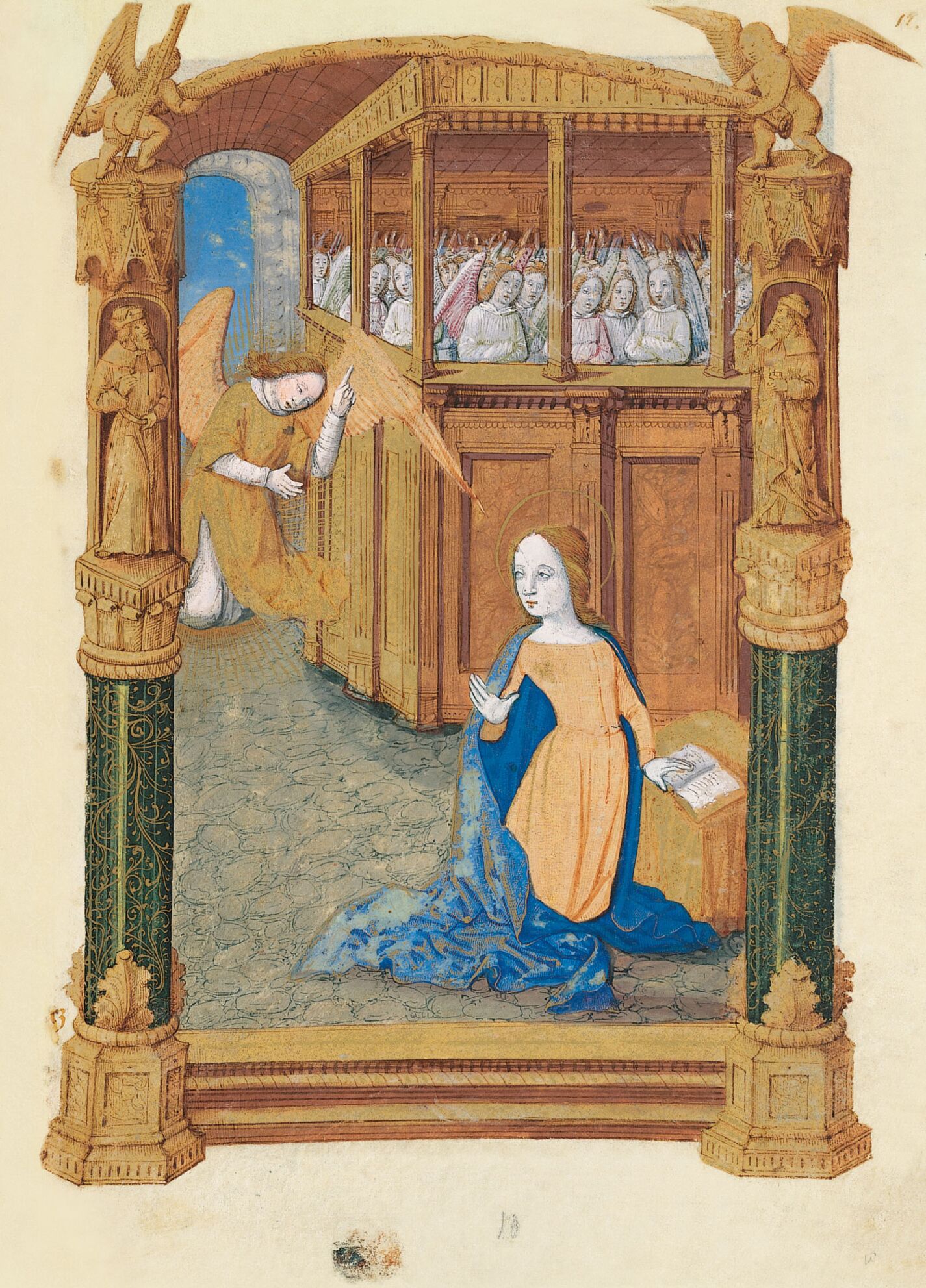The event takes place in an indoor setting which is possibly a religious building following the convention begun by the Boucicaut Master; or the sort of antechamber used by Jean Pucelle; or a mixture of both. However, it is always a unified space, unlike the homely tradition of the Netherlands, which emphasises the religious aspect more. Hence, logically enough, the frame must terminate with an arch extending into a vault, since in both France and Flanders, they still followed the trecentist idea of showing an indoor area by means of an outdoor view with an open front. Hence, the architecture surrounding the scene is but one last vestige of the decorative frame, whose function was to anchor the three-dimensional image within the flat page. The gilt statues of two men in niches that flank the scene in the frame could refer to Isaiah and Moses or Jeremiah, perhaps more likely the latter since the representation does not coincide with that of the liberator of Israel. Isaiah is the prophet intrinsically linked to the birth of the Saviour. This tradition going back to Early Christian art stems from Isaiah 7: 14, as can be seen in a scroll in one of the manuscripts of the Breviari d’Amor (Escorial, Monasterio de San Lorenzo el Real, ms. S.I.3, f. 95), amongst other works. They are both wearing long robes and caps with turned up brims. As E. Panofsky points out, this antithesis is probably an allusion to the contrast between the Old and New Testament, as can be seen in the Aix Annunciation Altarpiece attributed to Barthelemy d’Eyck, in which Isaiah is placed opposite Jeremiah. Whatever symbol was chosen, the figure representing the Old Testament was always placed to the left of Our Lady since the contrast between the two Testaments implies an opposition of values, one being superior to the other as expressed by the fundamental rule of their position. Besides, although columns are commonly found in this type of illustration to mark the different sections into which each office is divided, in this case they could be related to those of the Ancient Temple of Solomon – Jachin and Boaz. In the inside, on the left, the archangel Gabriel is surrounded by an aureole of golden rays, with his wings outspread and his index finger pointing upwards in an oratory gesture taken from the philosophers of old to expound the message from God, whilst the Virgin Mary, kneeling at a prie-dieu with an open book upon it – perhaps the prophecies – turns suddenly and shows her acceptance by her open hand with the palm turned outwards in a manner very similar to the same scene in a Franciscan missal dating from between 1483 and 1495 (Lyons, Bibliothèque municipale, ms. 514, f. 270r). Behind her is a Classicist golden choir with a host of angels worshipping the Blessed Virgin, which was to influence the subsequent iconography arising after the Council of Trent (1545-1563).
The position of the two main characters, the Virgin Mary and the archangel, corresponds to that of early 14th century Italian art, such as Giotto’s Annunciation (1305) in the triumphal arch of the Scrovegni Chapel in Padua. Under the influence of mysticism, the Blessed Virgin is depicted as beautiful, gentle and graceful. The table or prie-dieu with the book had already appeared in Carolingian and Ottonian times; hence from the viewpoint of literary sources, the Carolingian poem Krist by Otfried describes the Virgin Mary reading the Psalter when the angel arrives; whilst the Meditations says she is reading Isaiah’s prophecy.
